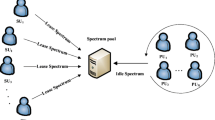Abstract
In Interactive Cognitive Radio Networks (ICRNs), secondary usage of spectrum is of competition and cooperation, and radio frequency environment is time-varying. In order to realize real-time secondary spectrum usage, coalition-competition architecture for the ICRNs is introduced in this paper. In the coalition-competition architecture, the ICRNs are divided into many coalitions according to geographical locations, utilization degree of spectrum, frequency range and transmission power level. There exists competition among different coalitions. In the same coalition with competition and cooperation, a model based on cooperative differential games is proposed to solve dynamic spectrum allocation, and cooperative equilibrium solution to the model is given and analyzed in this paper. From an overall perspective, the relationships between available spectrum percentage and the spectrum access rate are studied. How to form a coalition, and the mechanism to allocate total spectrum among secondary users considering Pareto optimality and individual rationality in the coalition are analyzed. The simulation results show the dynamic spectrum allocation model is fair and efficient, and it reflects realistically time-varying radio frequency environment. Cooperative differential games are particularly helpful for the spectrum management in the time-varying radio environment.
Similar content being viewed by others
References
DAILYWIRELESS.ORG. (2009). 4 Billion GSM Users: Sept. 2009. http://www.dailywireless.org/2009/08/21/4-billion-gsm-users-sept-2009/.
Mitola J. III, Maguire G. (1999) Cognitive radio: Making software radios more personal. IEEE Personal Communications 6(4): 13–18
Federal Communications Commission. (2003). Facilitating opportunities for flexible, efficient, and reliable spectrum use employing cognitive radio technologies. FCC Document ET Docket No. 03-108, Dec. (2003).
Zhao Q., Sadler B. (2007) A survey of dynamic spectrum access. IEEE Signal Processing 24(3): 79–82
Akyildiz I. F., Lee W. Y., Vuran M. C. et al (2006) Next generation/dynamic spectrum access/cognitive radio wireless networks: a survey. Computer Networks 50(13): 2127–2159
Mangold S., Jarosch A., Monney C. (2005) Cognitive radio-trends and research challenges. Swisscom Comtec Magazine 3: 6–9
Akyildiz I. F., Mohanty S., Xie J. (2005) A ubiquitous mobile communication architecture for next-generation heterogeneous wireless systems. IEEE Communications 43(6): s29–s36
Attar A., Ghorashi S. A., Sooriyabandara M., Aghvami A. H. (2008) Challenges of real-time secondary usage of spectrum. Computer Networks 52(4): 816–830
Akyildiz I. F., Lee W. Y., Chowdhury K. R. (2009) CRAHNs: Cognitive radio Ad hoc networks. Ad Hoc Networks Journal (Elsevier) 7(5): 810–836
Cheng S. L., Yang Z., Zhang H. (2007) Novel power control game algorithm for cognitive radios. Journal on Communications 28(3): 100–107
Cheng S. L., Yang Z., Zhang H. (2007) Novel cooperative power control game algorithm for cognitive radio systems. Journal on Communications 28(8): 54–60
Meshkati F., Poor H. V., Schwartz S. C. et al (2005) An energy-efficient approach to power control and receiver design in wireless data networks. IEEE Transactions on Communications 53(11): 1885–1894
Qiu J., Zou W. (2008) Study on dynamic frequency selection and power control in cognitive radio networks. Journal of System Simulation 20(7): 1821–1825
Zhao C., Wu Z. (2008) Interference avoidance algorithm based on game theory in CR system. Journal on Communications 29(3): 82–86
Ji Z., Liu K. (2008) Multi-stage pricing game for collusion-resistant dynamic spectrum allocation. IEEE Journal on Selected Areas in Communications 26(1): 182–191
Niyato D., Hossain E. (2008) Competitive pricing for spectrum sharing in cognitive radio networks: dynamic game, inefficiency of nash equilibrium, and collusion. IEEE Journal on Selected Areas In Communications 26(1): 192–202
Fette B. A. (2006) Cognitive radio technology. Elsevier, Burlington, USA
Ma Z., Zhou X., Wang H., Tu X. (2010) Study on dynamic spectrum management model for interactive cognitive radio. Chinese Journal of Electronics 19(1): 145–149
Haykin S. (2005) Cognitive radio: Brain-empowered wireless communication. IEEE Journal on Selected Areas in Communications 23(2): 201–220
Kim H., Shin K. G. (2008) Efficient discovery of spectrum opportunities with MAC-layer sensing in cognitive radio networks. IEEE Transactions on Mobile Computing 7(5): 533–545
Urgaonkar R., Neely M. J. (2009) Opportunistic scheduling with reliability guarantees in cognitive radio networks. IEEE Transactions on Mobile Computing 8(6): 766–777
Rodica B., Dinko D., Stef T. (2008) Models in cooperative game theory (2rd). Springer, New York
Von N., Morgenstern J. (1944) Theory of games and economic behavior. Princeton University Press, Princeton
Yeung D., Petrosyan L. (2006) Cooperative stochastic differential games. Springer, New York
Cordeiro C., Challapali K., Birru D., Shankar S. (2006) IEEE 802.22: An introduction to the first wireless standard based on cognitive radios. Journal of Communications 1(1): 38–47
Author information
Authors and Affiliations
Corresponding author
Rights and permissions
About this article
Cite this article
Ma, Z., Wang, H. Dynamic Spectrum Allocation with Maximum Efficiency and Fairness in Interactive Cognitive Radio Networks. Wireless Pers Commun 64, 439–455 (2012). https://doi.org/10.1007/s11277-010-0208-0
Published:
Issue Date:
DOI: https://doi.org/10.1007/s11277-010-0208-0




